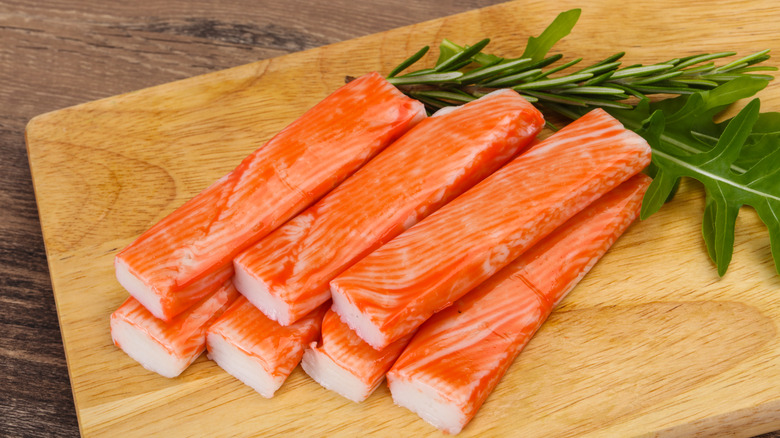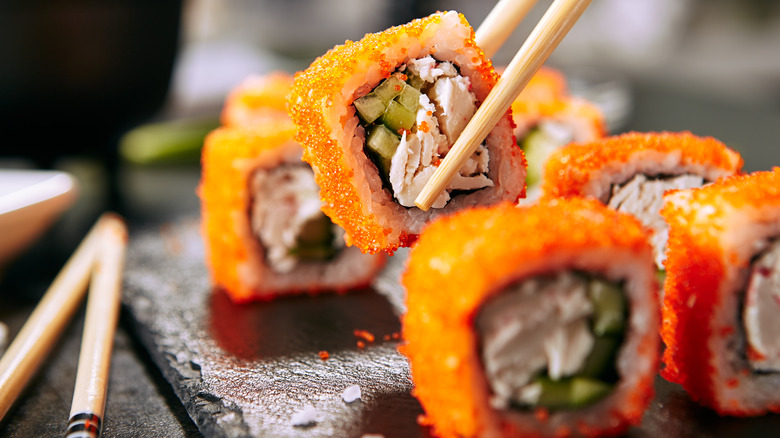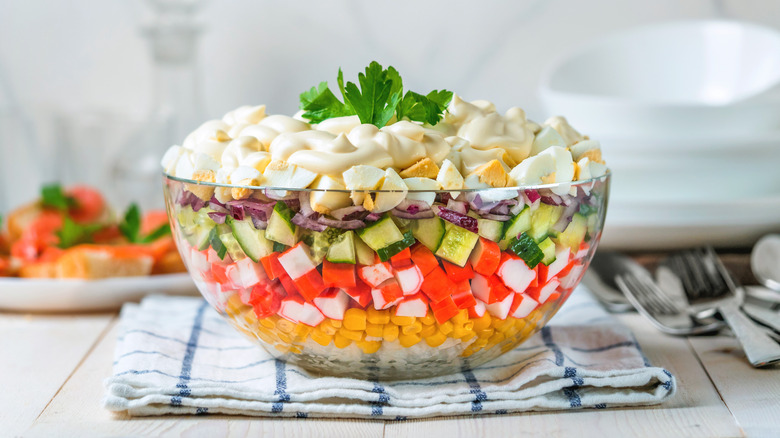What Vegetarians Need To Know About Imitation Crab
Imitation crab meat — sometimes called "crab stick" — is a beguiling ingredient. It is primarily known for its inclusion in California rolls, crab cakes, crab rangoon, seafood salads, and hot crab dip. The staple is also included in various other preparations, recipes, and dishes, but most are unaware of what exactly constitutes the product. Is it vegetarian? Is it vegan? Read ahead to find out.
Believe it or not, the primary ingredient in imitation crab is known as surimi, and it has actually been made for hundreds of years. Experts believe it might have been used in dishes for at least 900 years, according to Thrillist. Surimi itself was invented hundreds of years ago by Japanese chefs to repurpose unused fish scraps by grinding them down into a paste. This ingenuity was then capitalized on as time went on, and a more economical crab alternative became necessary for many chefs, supermarkets, home cooks, and restaurateurs.
What is imitation crab meat?
As noted by The Daily Meal, imitation crab is created by mixing fish like Atlantic pollock with starches to create a crab-like texture. The fish is mixed with egg whites, corn starch, potato starch, and sometimes a small amount of actual snow crab to give it a more authentic flavor. As far as the odd color? Red food coloring is added to provide it with a pinkish tinge. So clearly, the ingredients are not vegan or vegetarian.
From a price standpoint, crab certainly can be expensive, so the imitation version was conceptualized to provide a less extravagant alternative for varying dishes. Nutritionally, though, imitation crab is just that: an imitation. It is much less nutritious than real crab. But that doesn't mean it isn't healthy. Imitation crab contains omega-3s, and Thrillist points out that it is also low-fat and high in protein. However, SF Gate notes that surimi is not safe to ingest if you have gluten or wheat allergies. It can also contain many artificial ingredients, flavorings, and preservatives. But if you're only concerned about the flavor, many note that it is pretty similar to the real thing.
How is imitation crab made?
According to Allrecipes, the imitation crab we eat today originated in 1970s Japan as a budget-friendly alternative to crab meat. By the 1980s, it became commonplace in various countries, including the U.S. Allrecipes also delves into the production of imitation crab, stating that the imitation paste is squeezed into rectangular molds and then tinted with orange dye to give it a more "natural" color, which makes it more appetizing for grocery shoppers. Wild! Obviously, it's not the most natural product.
Thrillist states that imitation crab is incredibly popular around the world. However, Talking Fish acknowledges that this demand — and the fact that overfishing is an enormous issue from a sustainability and animal rights perspective — has severely impacted the fishing industry. However, Atlantic pollock, which is primarily used to make imitation crab, is underfished, making it a sustainable alternative. Could surimi or imitation crab become the 'fish' of the future? We'll see!


